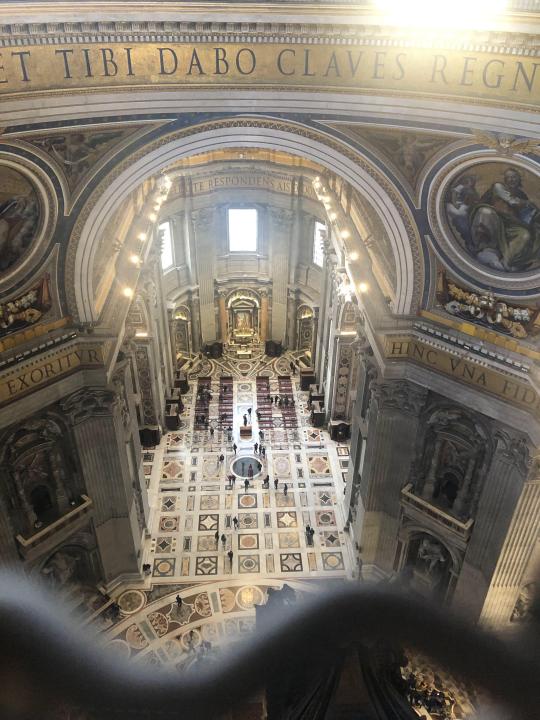#Cupola St. Peter's
Photo
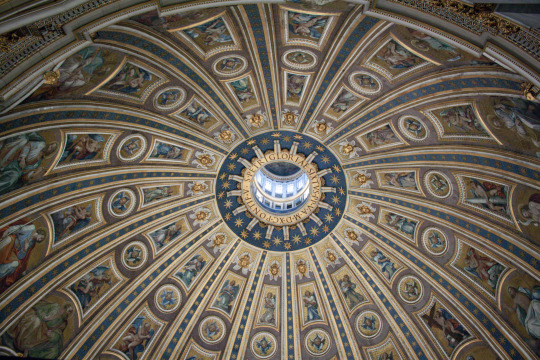




Stairway inside the Cupola of St Peter’s Basilica
#st peter's basilica#roviell#calopa#cupola#cablao#roviell cablao#roviell cablao cupola#vatican#italy
10 notes
·
View notes
Text

Views of Rome from the cupola of St. Peters.
#st peter's basilica#rome#roma#italy#italia#original photography#photography#travel#cityscape#urban photography#urban landscape#vatican#vatican city#photographers on tumblr#lensblr#historical architecture#architecture#wanderingjana
14 notes
·
View notes
Photo
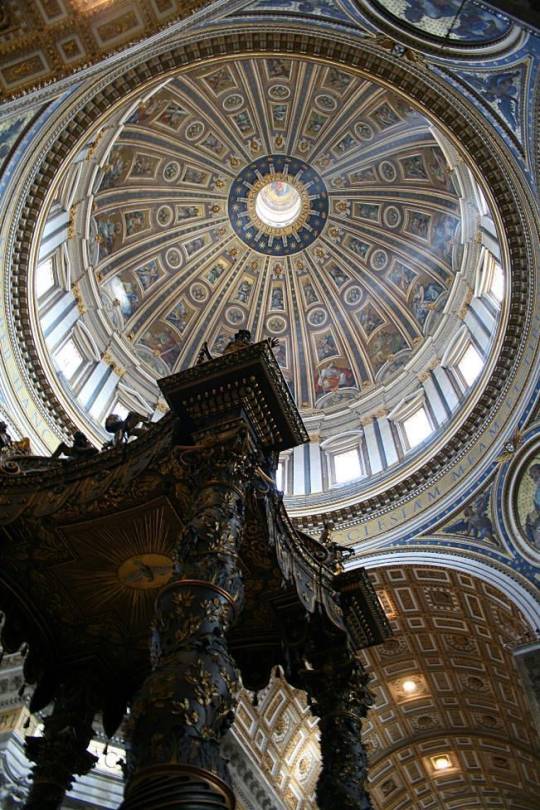
Michelangelo Buonarroti - Cupola, St. Peters Basilica, 1546, Vatican City
11 notes
·
View notes
Text

Una finestra del Palatino si apre sull'incantevole panorama della cupola di San Pietro.
A window on the Palatine opens to the enchanting panorama of St. Peter's dome.
📸 IG nico_m_photographie
Parco archeologico del Colosseo Ministero della Cultura museitaliani
#visitrome
2 notes
·
View notes
Text
La celebre piazza San Pietro nella città del Vaticano a Roma

La celebre piazza San Pietro nella città del Vaticano a Roma.
Uno dei monumenti che non si può mancare di visitare nella Città Eterna è sicuramente Piazza San Pietro, simbolo della cristianità nel mondo.
Non mi ricordavo che ci fossero tanti turisti in visita... e pensare che l'ultima volta che c'ero stato ero persino salito in cima alla cupola e non ricordo di aver aspettato in fila così tanto.
Conosci Roma? Aggiungi un tuo commento
The famous St. Peter's square in the Vatican city in Rome - La célèbre place Saint-Pierre dans la cité du Vatican à Rome - La famosa plaza de San Pedro en la ciudad del Vaticano en Roma - A famosa Praça de São Pedro na cidade do Vaticano, em Roma - Der berühmte Petersplatz in der Vatikanstadt in Rom - Quảng trường nổi tiếng có tên San Pietro ở thành phố Vatican ở Rome - 罗马梵蒂冈城著名的圣彼得广场 - ローマのバチカン市国にあるサン・ピエトロ広場と呼ばれる有名な広場
Read the full article
#basilica#chiesa#Cittàdelvaticano#cittaeterna#colonnato#cupolone#ErCupolone#lazio#piazza#roma#sanpietro
0 notes
Link
1 note
·
View note
Photo
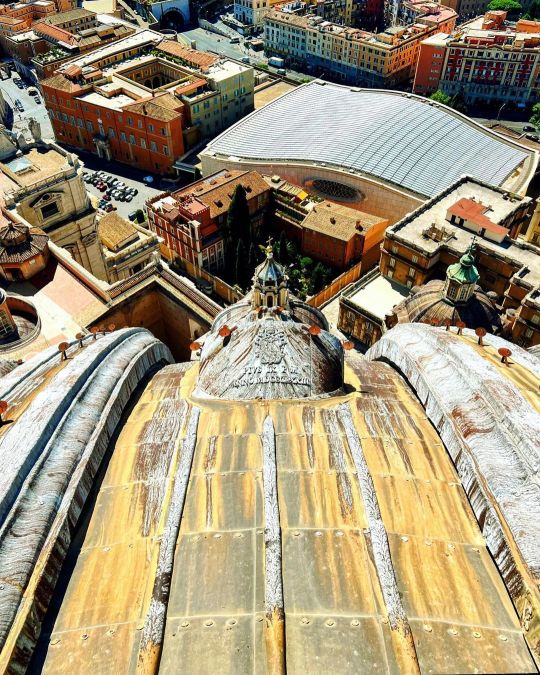
The Dome of St. Peter's Basilica in Vatican City is covered with a total of 8,909 plates of bronze and copper. These plates were installed in 1626 and were designed by Gian Lorenzo Bernini. #IlikeItaly #Italy #Roma #Rome #VisitRome #igersitalia #IgersRoma #RaccontandoRoma #vaticanmuseums #StPetersBasilica #SanPietroinVaticano (at Cupola San Pietro Roma) https://www.instagram.com/p/CoNm4d-vvtl/?igshid=NGJjMDIxMWI=
#ilikeitaly#italy#roma#rome#visitrome#igersitalia#igersroma#raccontandoroma#vaticanmuseums#stpetersbasilica#sanpietroinvaticano
0 notes
Text
Day 35
17 July
The last day. The four of us left our apartment at the same time to go to the Rome Center at Campo dei Fiori and check out. A lot of people who would be traveling elsewhere in Europe would only be bringing backpacks or duffels with them, and would be storing their large luggage at the Rome Center, where they would return and fly out of later. Kathryn was flying back home, I think, but Kim and Kendra were continuing onward, to Florence and beyond. I had a full day before my flight left, but wanted to run some last minute errands, so I left the apartment with them.
At the Rome Center, we ran into many of our classmates and I decided to tag along with them for the day-- Sarah, Tessa M, Tessa C, and Emilie were also hanging around for the day. Sarah and Tessa M were flying out the next day, I believe, but were staying in a hostel near Termini, which I needed to get to to catch a bus to the airport. Tessa C and Emilie were traveling more, but their flights wouldn’t leave until the next day either, and I don’t remember what their plans were in the meantime.
Someone had to go to the Vatican to get some stamps or mail something, and I figured I might as well mail the postcards I had been forgetting about there as well (whoops!) so we set off one last time to the Holy Land.
“Goodbye,” I said to myself everywhere we passed-- the Tiber river; the bridge with the golden statues; the long street where Mussolini barreled down it in a tank some decades before; St. Peter’s and the Cupola.
Hungry, we went and got lunch at a small, family-run place in a small alleyway-- by now, we were experts at finding the best places to eat that weren’t so touristy-- and, of course, we all wanted to get one last gelato.
As I did yesterday, we went to San Crispino’s and got gelato, and then (without getting lost!) made our way to my favorite, Piazza Navona.
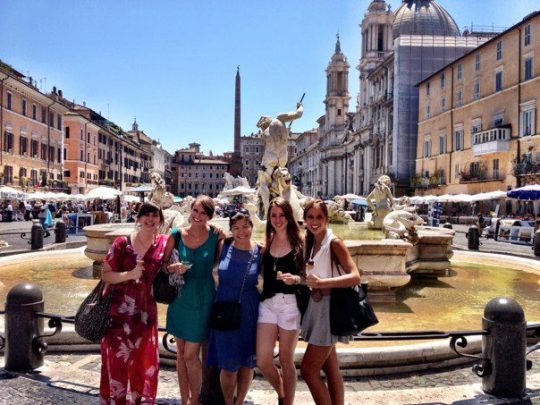
It was nice, hanging out with them all, especially since I hadn’t much during our time there. Tessa M and I were in the same cohort, and Sarah and I had sat with each other a few times on long bus rides, but I hadn’t spent much time with Tessa C and Emilie.
We went back to the Rome Center and grabbed our luggage-- Emilie and Tessa C were staying behind, but Tessa M, Sarah, and I shared a cab to Termini, where I bid them farewell and went to find my bus. No one could tell me-- in English or Italian-- where this bus was, so I ended up buying another ticket for a different bus that I knew would get me there.
As the bus rolled out of Rome, and the city opened into wide, open spaces, I felt melancholic. I felt like things had been happening so quickly and now time had finally slowed down, and it was like I was just coming out of a whirlwind or a daze.
There were things to look forward to, at least. I was going to Hawaii the next month to see my family, and it would be nice to see my friends at home, too. But a fear still gripped me that perhaps I would never be back to Rome, but, well-- you can’t let fear rule you. I loved it, and I would find a way back.
0 notes
Text
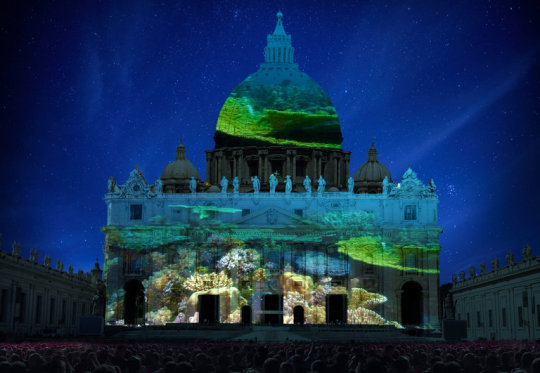



The Road to a Paris Climate Deal
By The New York Times
youtube
A pact to slow global warming was reached Saturday. We’re providing insights and analysis.
Q. and A.
Artistic renderings of images that will illuminate St. Peter’s Basilica. Steve McCurry, Yann Arthus-Bertrand, David Doubilet, Emmett Feldman, artistic rendering by Obscura Digital.
An Environmental Message, From and on the Vatican
2015-12-04T07:26:50-05:00 December 4, 2015
VATICAN CITY — This week, the facade and cupola of St. Peter’s Basilica, normally a brightly lit beacon in the capital’s sky, went dark for a few hours, throwing the Italian news media into high alert.“Black out and fear for an electrical failure at St. Peter’s,” read one alarmist headline the next day. Other newspapers reported rumors of an antiterrorism drill.The power cut was actually part of a technical dress rehearsal for “Fiat Lux: Illuminating Our Common Home,” a gift from a coalition and a public art projection on the facade of St. Peter’s timed to coincide with the climate talks in Paris. It is also part of the inauguration of the Roman Catholic Church’s yearlong Jubilee of Mercy, which starts Dec. 8.The Basilica was darkened because “the show needs moments of preparation to ensure its success,” Archbishop Rino Fisichella, president of the Pontifical Council for Promoting New Evangelization, said at a news conference on Friday. “I can assure everyone that it is a unique event for its genre and for the fact that it is being displayed for the first time on such a significant backdrop.”“We are grateful for the gift and hope that many people will be able to enjoy it throughout the world,” said the archbishop, whose pontifical council is in charge of overseeing the Jubilee. The event will be streamed online at OurCommonHome.World.Inspired by Pope Francis’ 2015 encyclical on the environment, “Laudato Si: On Care for Our Common Home,” along with St. Francis’ 800-year old Canticle of the Creatures, the hourlong projection is both a celebration of the beauty of creation but also a cautionary tale about the potentially devastating consequences of human impact on nature.Using the language of “visual poetry,” the light show means to reinforce the idea “of a responsible stewardship for our common home,” a notion touched on by both the current Francis and the earlier one, said the artist Travis Threlkel, one of the curators of the project, which signals the start of the Jubilee but also the United Nations Framework Convention on Climate Change, known as COP21, which continues in Paris through Dec. 11.“We’re showing the diversity and glory of God’s creation on the planet, and we’re hoping to inspire the world to have reverence for all things,” Mr. Threlkel said by telephone from his office in San Francisco, where his company, Obscura Digital, is based. The digital projections will cover both the dome of the Basilica, designed in the mid-16th century by Michelangelo, and the facade, designed by Carlo Maderno about 70 years later.In keeping with the saint who inspired his papal name, Francis has made environmental justice a cornerstone of his vision. His encyclical, issued in June, forcefully calls for action to stem environmental destruction and climate change, which has the most adverse impact on the world’s poor.Warning last week in Nairobi, Kenya, that it would be “catastrophic” if particular interests were to prevail over the common good, Francis expressed the hope that the climate conference in Paris would “achieve a global and transformational agreement based on the principles of solidarity, justice, equality and participation; an agreement which targets three complex and interdependent goals: lessening the impact of climate change, fighting poverty and ensuring respect for human dignity.”The projection will begin Tuesday evening, just hours after Francis opens the Holy Door in St. Peter’s Basilica, inaugurating the holy year. More than 50 projectors perched on towers will display digital images by some of the world’s best known nature and humanistic photographers and filmmakers, including Sebastião Salgado, Joel Sartore, Yann Arthus-Bertrand and Louie Schwartzberg, onto the front of one of the world’s most noted churches.The projection will be repeated three times. It will also be broadcast by a Vatican television station and streamed online.Images will include forests, oceans, wetlands, flora and fauna, intersecting and interacting with the modulated Renaissance and
Baroque architecture of the Basilica, and woven together into what Mr. Threlkel described as a “visual symphony with various movements and overtures.”Black-and-white photographs from different indigenous cultures, by Mr. Salgado, merge into rare deep sea images by Howard Hall and David Doubilet that run into portraits of endangered species that Mr. Sartore took for his “Photo Ark,” a National Geographic photography project that aims to capture the world’s captive species.The Vatican, Mr. Threlkel said, was very supportive. “For them, it was in line with what the church has always done, working with artists” throughout history, he said. “Today, using technology and media is the church’s way of being active in the art world.”— Elisabetta Povoledo
https://www.nytimes.com/interactive/projects/cp/climate/2015-paris-climate-talks/an-environmental-message-from-and-on-the-vatican
VATICAN CITY — This week, the facade and cupola of St. Peter’s Basilica, normally a brightly lit beacon in the capital’s sky, went dark for a few hours, throwing the Italian news media into high alert.
“Black out and fear for an electrical failure at St. Peter’s,” read one alarmist headline the next day. Other newspapers reported rumors of an antiterrorism drill.
The power cut was actually part of a technical dress rehearsal for “Fiat Lux: Illuminating Our Common Home,” a gift from a coalition and a public art projection on the facade of St. Peter’s timed to coincide with the climate talks in Paris. It is also part of the inauguration of the Roman Catholic Church’s yearlong Jubilee of Mercy, which starts Dec. 8.
The Basilica was darkened because “the show needs moments of preparation to ensure its success,” Archbishop Rino Fisichella, president of the Pontifical Council for Promoting New Evangelization, said at a news conference on Friday. “I can assure everyone that it is a unique event for its genre and for the fact that it is being displayed for the first time on such a significant backdrop.”
“We are grateful for the gift and hope that many people will be able to enjoy it throughout the world,” said the archbishop, whose pontifical council is in charge of overseeing the Jubilee. The event will be streamed online at OurCommonHome.World.
Inspired by Pope Francis’ 2015 encyclical on the environment, “Laudato Si: On Care for Our Common Home,” along with St. Francis’ 800-year old Canticle of the Creatures, the hourlong projection is both a celebration of the beauty of creation but also a cautionary tale about the potentially devastating consequences of human impact on nature.
Using the language of “visual poetry,” the light show means to reinforce the idea “of a responsible stewardship for our common home,” a notion touched on by both the current Francis and the earlier one, said the artist Travis Threlkel, one of the curators of the project, which signals the start of the Jubilee but also the United Nations Framework Convention on Climate Change, known as COP21, which continues in Paris through Dec. 11.
“We’re showing the diversity and glory of God’s creation on the planet, and we’re hoping to inspire the world to have reverence for all things,” Mr. Threlkel said by telephone from his office in San Francisco, where his company, Obscura Digital, is based. The digital projections will cover both the dome of the Basilica, designed in the mid-16th century by Michelangelo, and the facade, designed by Carlo Maderno about 70 years later.
In keeping with the saint who inspired his papal name, Francis has made environmental justice a cornerstone of his vision. His encyclical, issued in June, forcefully calls for action to stem environmental destruction and climate change, which has the most adverse impact on the world’s poor.
Warning last week in Nairobi, Kenya, that it would be “catastrophic” if particular interests were to prevail over the common good, Francis expressed the hope that the climate conference in Paris would “achieve a global and transformational agreement based on the principles of solidarity, justice, equality and participation; an agreement which targets three complex and interdependent goals: lessening the impact of climate change, fighting poverty and ensuring respect for human dignity.”
The projection will begin Tuesday evening, just hours after Francis opens the Holy Door in St. Peter’s Basilica, inaugurating the holy year. More than 50 projectors perched on towers will display digital images by some of the world’s best known nature and humanistic photographers and filmmakers, including Sebastião Salgado, Joel Sartore, Yann Arthus-Bertrand and Louie Schwartzberg, onto the front of one of the world’s most noted churches.
The projection will be repeated three times. It will also be broadcast by a Vatican television station and streamed online.
Images will include forests, oceans, wetlands, flora and fauna, intersecting and interacting with the modulated Renaissance and Baroque architecture of the Basilica, and woven together into what Mr. Threlkel described as a “visual symphony with various movements and overtures.”
Black-and-white photographs from different indigenous cultures, by Mr. Salgado, merge into rare deep sea images by Howard Hall and David Doubilet that run into portraits of endangered species that Mr. Sartore took for his “Photo Ark,” a National Geographic photography project that aims to capture the world’s captive species.
The Vatican, Mr. Threlkel said, was very supportive. “For them, it was in line with what the church has always done, working with artists” throughout history, he said. “Today, using technology and media is the church’s way of being active in the art world.”.
https://www.nytimes.com/interactive/projects/cp/climate/2015-paris-climate-talks/an-environmental-message-from-and-on-the-vatican
1 note
·
View note
Text
Tour della Basilica di San Pietro, con Grotte e Cupola in un Piccolo Gruppo 2022 - Roma
0 notes
Photo

MWW Artwork of the Day (5/12/21)
Michelangelo Buonarroti (Italian, 1475-1564)
Cupola, St. Peter's Basilica (designed 1546)
Vatican City
Michelangelo Buonarroti was one of the creative giants whose achievements mark the High Renaissance. He excelled in each of the fields of painting, sculpture and architecture and his achievements brought about significant changes in each area. His architectural fame lies chiefly in two buildings: the interiors of the Laurentian Library and its lobby at the monastery of San Lorenzo in Florence, and St. Peter's Basilica in Rome. St. Peter's was "the greatest creation of the Renaissance", and a great number of architects contributed their skills to it. But at its completion, there was more of Michelangelo’s design than of any other architect, before or after him.
Michelangelo’s dome was a masterpiece of design using two masonry shells, one within the other and crowned by a massive lantern supported, as at Florence, on ribs. For the exterior of the building he designed a giant order which defines every external bay, the whole lot being held together by a wide cornice which runs unbroken like a rippling ribbon around the entire building.
7 notes
·
View notes
Text
St. Peter’s, Necropolis, St. Peter’s Tomb, Top of the Cupola
“St. Peter’s has made me realize that Art, like Nature, can abolish all standards of measurements.” —J. W. Goethe
To anyone who visits the site, it’s very obvious that looking at pictures of St. Peter’s don’t do it any justice. You don’t realize how massive everything is until you’re standing in the middle of the square, attempting to analyze the scale of your surroundings. What’s really impressive are the set of columns on either sides of the piazza, which the famous architect, Bernini, somehow managed to bring to life. It doesn’t matter where you’re standing in the square because the colonnades look as if they’re moving and pointing to the most important monument in the Vatican, St. Peter’s Basilica. The framing of the piazza exudes this sense of dramatic embrace even more once you look up and see the statues of saints aligning at the top of the colonnade. But you don’t need to be a Christian to appreciate the work put into making this extraordinary place, you just need to appreciate art.


As you walk past the fountain and the Egyptian obelisk, you’re met with east face of the Basilica which is, in itself, a masterpiece, designed by another famous architect, Maderno. It’s one thing to see it from far away and another to stand beneath it. The moment you do enter the Basilica, you are stunned by the sheer size of it. Even if you stripped away the art, the symbolism embedded in each inch, and the history written across the walls, you’d still be able to find something majestic and incomprehensible about the building. The spirituality is felt with every step, and again, it doesn’t matter what your religion is, or if you even have one, because the art, combined with the philosophy and science behind the raising of this church, make this an almost out-of-body experience. As you’re standing under Michelangelo’s dome, you’re overcome by the space around you because you aren’t just looking at architecture, but you’re taking in architecture that is created by sculptural programs. It is literally the hub of art and it’s difficult to appreciate! The Baldacchino, which is one of the altars in the church, attempts to put things into perspective since it looks like it stretches up to the dome, both literally and symbolically.


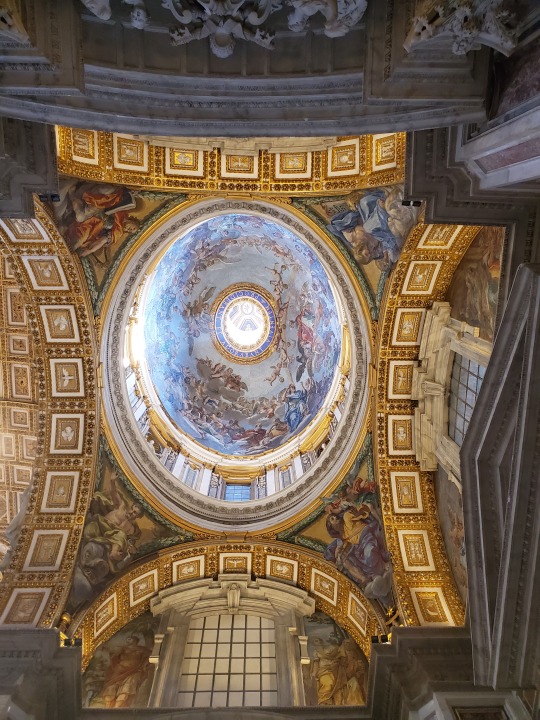
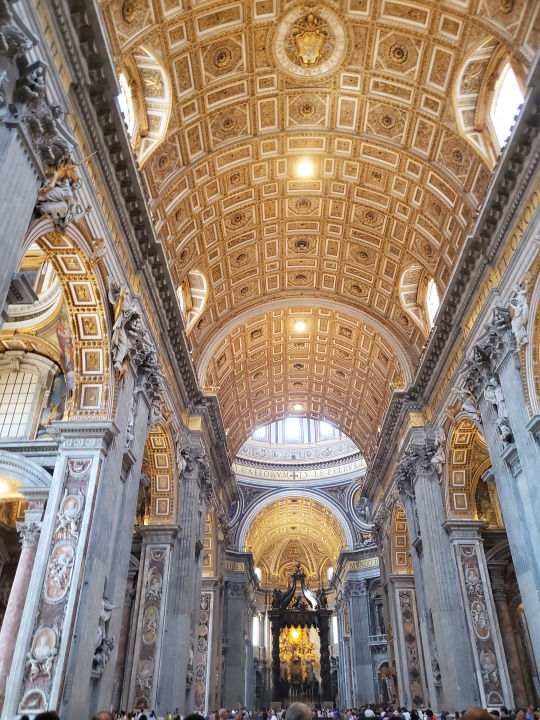


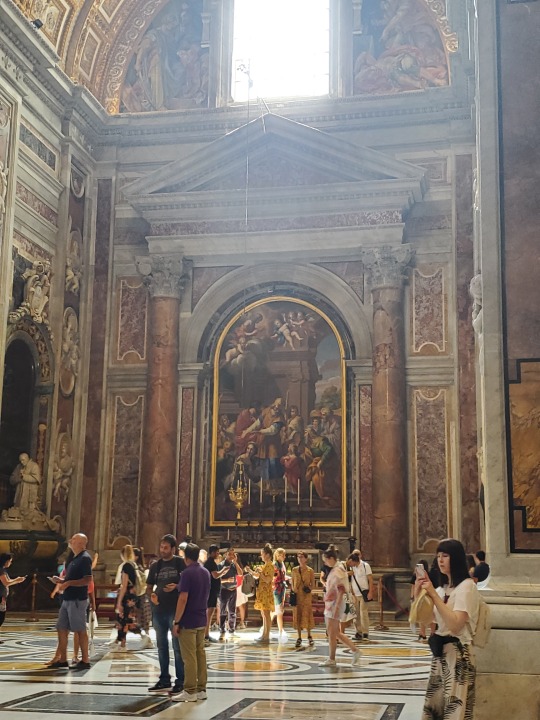
The Baldacchino also marks the site of the burial of St. Peter which is right below in the crypt. As you descend to the Vatican Necropolis, you get a sense of what the original paths looked like in Roman times. A bit claustrophobic to those of us who don’t like tight spaces or enjoy walking along passages with hundreds of tombs. It’s a bit cliché but the history is felt in the air. The frescoes and original tiles and marble coffins give off ancient and modern vibes and you just feel “more” of something. Once you get to the spot where St. Peter was allegedly buried, it is quite breathtaking. It doesn’t matter if the ancient graffiti “Peter is here” is real or not because in that moment, you’re standing in front of the bones of someone who, at a point in history, was considered holy. It’s an emotional experience any way you look at it.
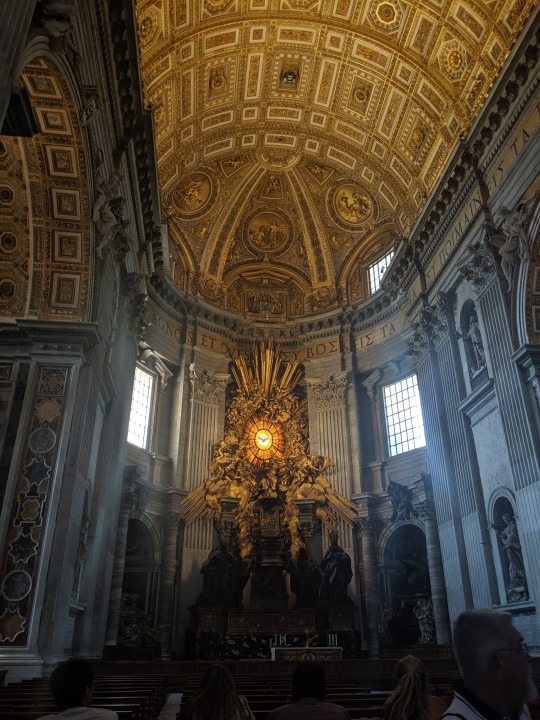
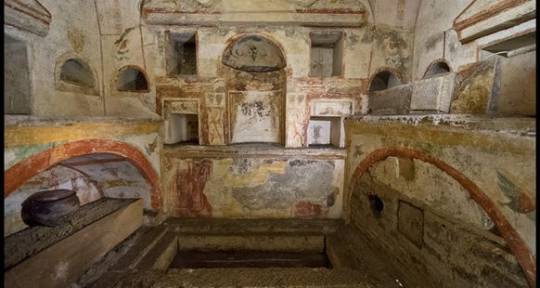
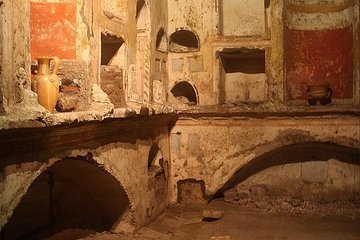
Heading up to the top of the Cupola, you have to ascend some hundred, narrow, steps and it gets your adrenaline kicking. Before you walk out onto the roof of the Basilica, you stop at the inside of Michelangelo’s dome and if the scale threw you off when you were standing under it, then it is twice as terrifying from the top because things just somehow look even bigger. But it’s also gorgeous because the mosaics up close are magical. Once you do step outside, you’re met with the statue of Jesus sand the apostles, and a fantastic panoramic view of the Vatican and Rome! It doesn’t matter what time of day you go up there because the picture of the city seems unreal.
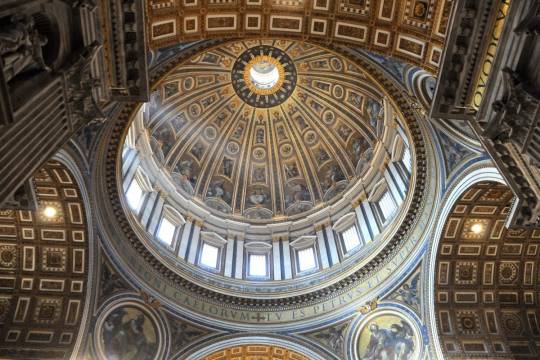

#St. Peter's Square#St. Peter's Basilica#St. Peter's#Vatican Necropolis#St. Peter's Tomb#St. Peter's Cupola#Vatican City#Rome
1 note
·
View note
Photo
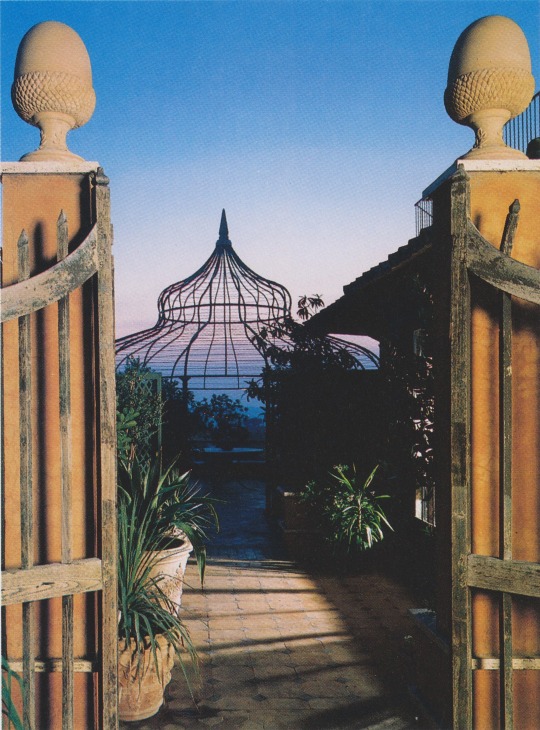
Gazebo by Mongiardino echoes cupola of St. Peter’s. Terra-cotta acorns, vases by Tobie Loup de Viane, who transformed terrace planting. Gate from an old convent.
House & Garden’s Best in Decoration, 1987
#vintage#vintage interior#1980s#interior design#home decor#garden#landscape design#gate#terra cotta#plant pots#gazebo#cupola#plants#Mongiardino#Italian#European#style#home#architecture
387 notes
·
View notes
Text
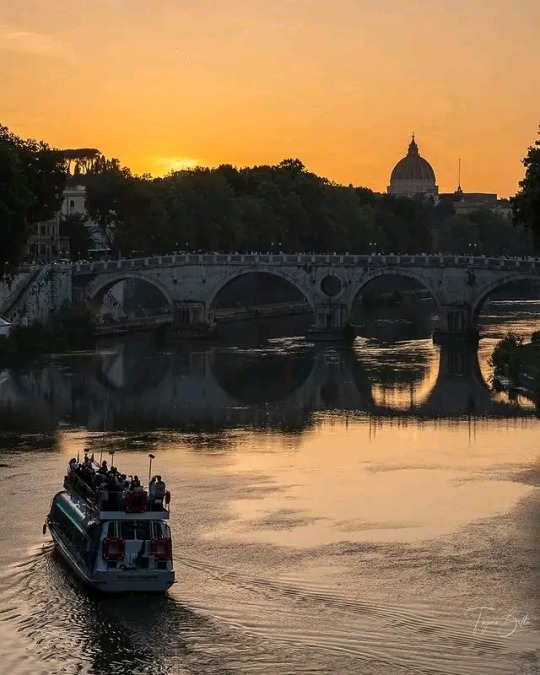
Ponte Sisto, sullo sfondo la cupola di San Pietro, mentre il battello solca le acque del Tevere: un momento sospeso nella serenità di un tramonto...
Ponte Sisto, in the background St. Peter's dome, as the boat cuts through the waters of the Tiber: a moment suspended in the serenity of a sunset...
📸 IG tittibelli_foto
#visitrome
1 note
·
View note
Photo


Cupola of St. Peter's Basilica in Vatican City
#look at this#me actually posting vacation pics? never seen before#it's a first (i think)#i snapped 800 okayish pics overall so i thought i'd share some in the next couple of weeks#we spend 10euros to get up into the cupola and farther up to the top of the dome#totally worth it#the best ones i took are probably from the vatican city#and pics i made at sunset from the vatican skyline#honestly the view from the rooftop garden was the pretties thing i have ever seen#i was in awe the entire time#if you follow my instagram you have probably seen the pics#rome#vatican city#*pics#*all#*ph#ph#aes#architecture#places
1K notes
·
View notes
